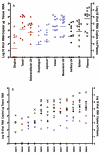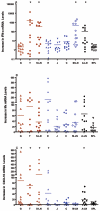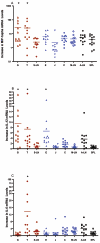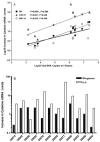Rapid virus dissemination in infant macaques after oral simian immunodeficiency virus exposure in the presence of local innate immune responses
- PMID: 16775324
- PMCID: PMC1488945
- DOI: 10.1128/JVI.02240-05
Rapid virus dissemination in infant macaques after oral simian immunodeficiency virus exposure in the presence of local innate immune responses
Abstract
A vaccine to protect human immunodeficiency virus (HIV)-exposed infants is an important goal in the global fight against the HIV pandemic. Two major challenges in pediatric HIV vaccine design are the competence of the neonatal/infant immune system in comparison to the adult immune system and the frequent exposure to HIV via breast-feeding. Based on the hypothesis that an effective vaccine needs to elicit antiviral immune responses directly at the site of virus entry, the pattern of virus dissemination in relation to host immune responses was determined in mucosal and lymphoid tissues of infant macaques at 1 week after multiple oral exposures to simian immunodeficiency virus (SIV). The results show that SIV disseminates systemically by 1 week. Infant macaques can respond rapidly to virus challenge and mount strong innate immune responses. However, despite systemic infection, these responses are most pronounced in tissues close to the viral entry site, with the tonsil being the primary site of virus replication and induction of immune responses. Thus, distinct anatomic compartments are characterized by unique cytokine gene expression patterns. Importantly, the early response at mucosal entry sites is dominated by the induction of proinflammatory cytokines, while cytokines with direct antiviral activity, alpha/beta interferons, are only minimally induced. In contrast, both antiviral and proinflammatory cytokines are induced in lymphoid tissues. Thus, although infant macaques can respond quickly to oral viral challenge, the locally elicited immune responses at mucosal entry sites are likely to favor immune activation and thereby virus replication and are insufficient to limit virus replication and dissemination.
Figures





References
-
- Abel, K., M. J. Alegria-Hartman, K. Zanotto, M. B. McChesney, M. L. Marthas, and C. J. Miller. 2001. Anatomic site and immune function correlate with relative cytokine mRNA expression levels in lymphoid tissues of normal rhesus macaques. Cytokine 16:191-204. - PubMed
-
- Abel, K., L. La Franco-Scheuch, T. Rourke, Z. M. Ma, V. De Silva, B. Fallert, L. Beckett, T. A. Reinhart, and C. J. Miller. 2004. Gamma interferon-mediated inflammation is associated with lack of protection from intravaginal simian immunodeficiency virus SIVmac239 challenge in simian-human immunodeficiency virus 89.6-immunized rhesus macaques. J. Virol. 78:841-854. - PMC - PubMed
-
- Akbar, A. N., J. M. Lord, and M. Salmon. 2000. IFN-alpha and IFN-beta: a link between immune memory and chronic inflammation. Immunol. Today 21:337-342. - PubMed
Publication types
MeSH terms
Substances
Grants and funding
LinkOut - more resources
Full Text Sources
Medical

